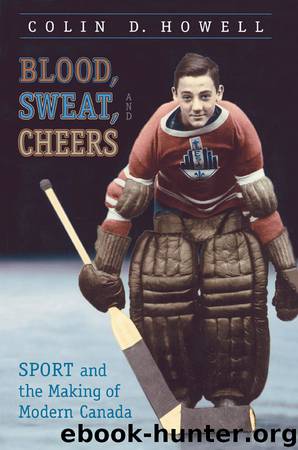Blood, Sweat, and Cheers: Sport and the Making of Modern Canada (Themes in Canadian History) by Colin Howell

Author:Colin Howell [Howell, Colin]
Language: eng
Format: epub
Publisher: University of Toronto Press, Scholarly Publishing Division
Published: 2001-05-29T23:00:00+00:00
Conclusion
Since the middle of the nineteenth century there has been a growing affinity between sport and the marketplace in Canada. Connected to this has been a debate over ownership: Who should own sport, and for what purpose? In this chapter I have tried to demonstrate that this debate has always existed. Before the First World War, sporting discourses centred on amateurism and professionalism, respectability and rowdyism, capitalist enterprise and working class fraternalism, manly character and civic worth, community identity and economic development. Sport had obvious economic benefits, and provided business opportunities for large and small capitalists alike; yet there were many who believed that when sport was attached to the market, its potential for encouraging social responsibility and moral improvement was undermined. For elite sportsmen, the amateur tradition constituted a defence against the win-at-all-costs professionalism and rowdy spectators, and ensured that sport would not be diffused downward to the working class. Workers, for their part, turned to sport as a means of demonstrating their own self-worth and respectability, and of combatting the more demeaning prejudices of those bourgeois improvers who wished to colonize the leisure pursuits of the working class in the interest of respectability and order.
After the First World War, sport was more closely linked to the emerging consumer society and to notions of personal happiness and fulfilment. Increasingly, corporations and individual capitalists were turning high-performance sport into a commodity and presenting it for sale in the marketplace. This process was encouraged by newspapers and radio and eventually by television. By venerating competitive sporting performance, the media helped fashion a cult of athletic heroes; it then made those heroes available to the reading, listening, and watching public. Today’s sporting hero is likely to be a professional athlete who commands a colossal salary and endorsement revenues, but this was not always the case. Before the Second World War it was still possible to accommodate amateurism and high-performance athletics and at least partly resist attempts by capitalist promoters to control high-level sport for profit. Examples of the constraints against full-blown professionalism are numerous, but nowhere are they more evident than in the Olympic Games. Yet as recent events have demonstrated, the games themselves have succumbed to commercial interests. Over the past two decades the IOC has ended its restrictions against the involvement of professionals, having recognized the hypocrisy of maintaining amateurism for athletes when the games have become a commercialized circus.
To understand this transition, we must turn our attention away from those who promote, administer, and play sport, and consider those who consume it. In the next chapter I focus upon those who cheered sport on, idealized their athletic heroes, and in the process made sport a fundamental component of Canadian life and the contemporary social order.
Download
This site does not store any files on its server. We only index and link to content provided by other sites. Please contact the content providers to delete copyright contents if any and email us, we'll remove relevant links or contents immediately.
| Africa | Americas |
| Arctic & Antarctica | Asia |
| Australia & Oceania | Europe |
| Middle East | Russia |
| United States | World |
| Ancient Civilizations | Military |
| Historical Study & Educational Resources |
Cat's cradle by Kurt Vonnegut(14786)
Pimp by Iceberg Slim(13809)
Underground: A Human History of the Worlds Beneath Our Feet by Will Hunt(11850)
4 3 2 1: A Novel by Paul Auster(11823)
The Radium Girls by Kate Moore(11642)
Wiseguy by Nicholas Pileggi(5336)
American History Stories, Volume III (Yesterday's Classics) by Pratt Mara L(5141)
Perfect Rhythm by Jae(5084)
The Fire Next Time by James Baldwin(5034)
Paper Towns by Green John(4815)
Pale Blue Dot by Carl Sagan(4633)
A Higher Loyalty: Truth, Lies, and Leadership by James Comey(4568)
The Mayflower and the Pilgrims' New World by Nathaniel Philbrick(4288)
The Doomsday Machine by Daniel Ellsberg(4254)
Killers of the Flower Moon: The Osage Murders and the Birth of the FBI by David Grann(4199)
Too Much and Not the Mood by Durga Chew-Bose(4105)
The Sympathizer by Viet Thanh Nguyen(4100)
The Borden Murders by Sarah Miller(4033)
Sticky Fingers by Joe Hagan(3918)
